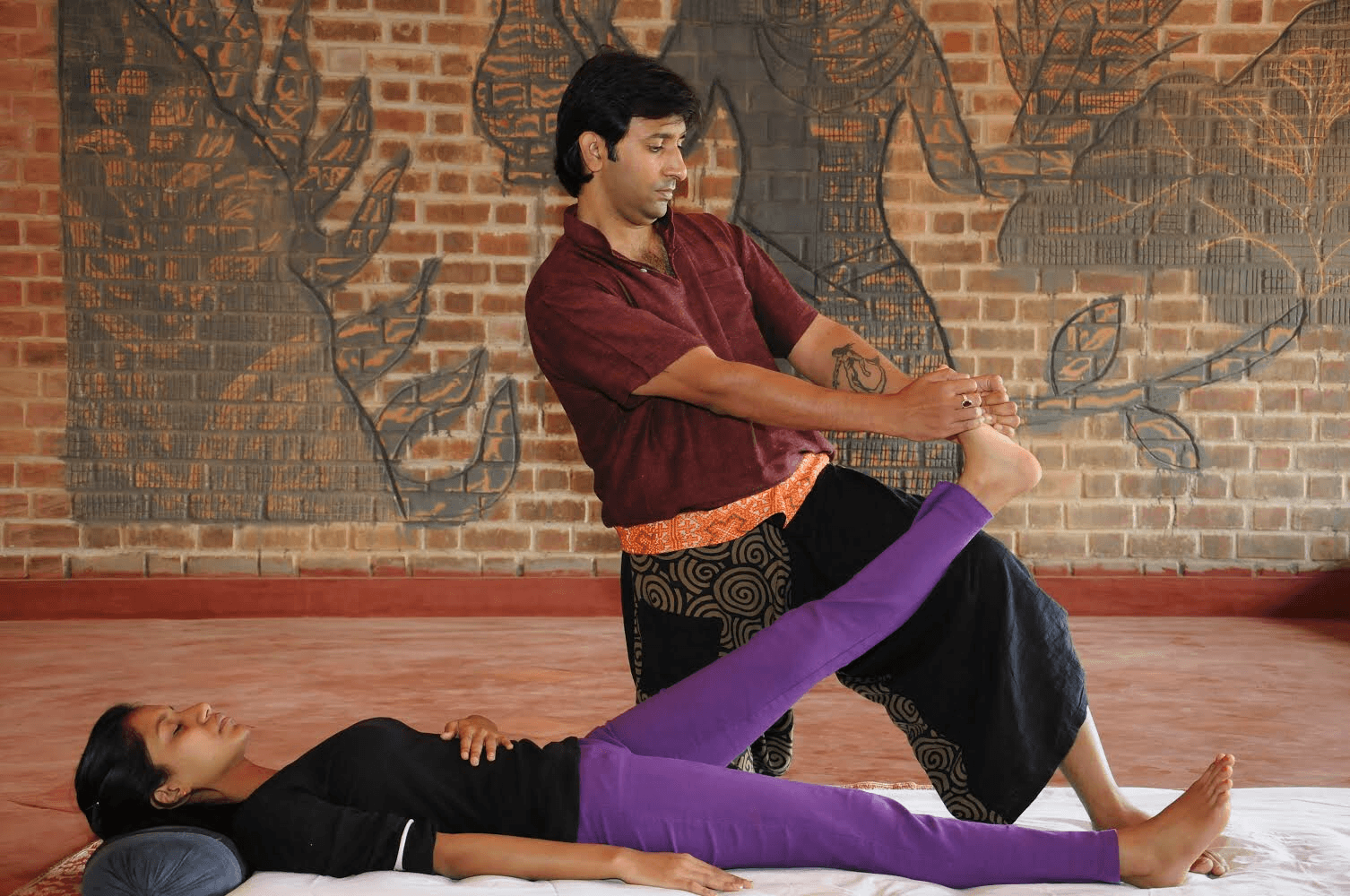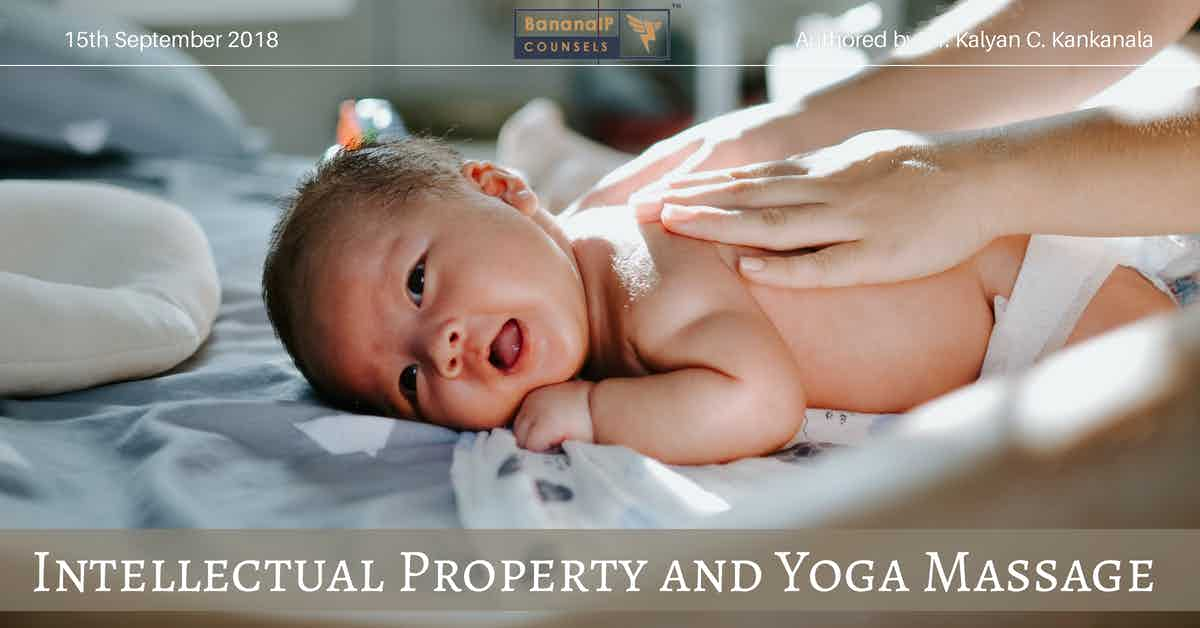“Working with the body is an art more than a skill,” Mr. Raghavendra tells his students of ‘Yoga Massage’ in his very first class.
It is in fact fascinating to watch him express, original body work with elements of creativity that surpass intellectual property standards and take a substantial lead. While many body work sequences are based on traditional practices, several practitioners and therapists have over the years developed novel and creative sequences for various reasons ranging from recipient requirement to purely artistic expression. It might not be an exaggeration to state that every practitioner creates and performs original postures, sequences, and techniques while practising rejuvenation and theraputic massage methods. Though most of their creativity is protectable under different forms of intellectual property, very few care about protecting their creative and inventive work.

When I asked Mr. Raghavendra if he would consider patent protection for his novel body work and ‘Yoga Massage’ techniques, he said, “No. That thought never crossed my mind. I believe that sharing is better than keeping.” I tried convincing him, but for trade mark and copyright filings for his unique teaching materials, he was not interested in protecting any of his inventive methods, techniques and sequences. That was more or less the outlook of almost all performers and authors associated with traditional art forms we had interacted with.
Body Work/Massage Patents
With the twin objective of understanding if any practitioner has protected body work or massage techniques/methods as patents and to check if there is freedom to operate any patented sequences/methods, we performed a very generic patent search. Following the search, we identified some interesting patent documents. We are hereby sharing some of them for your reference.
1. This relates to a patent application to perform massage with feet by holding a rope to support and balance.
Title: AN ADVANCED NOVEL ROPE MASSAGE DONE BY BARE FEET, PROVIDING RELAXATION TO THE TIRED AND STIFFED MUSCLES
Applicant: MRS. REKHA CHAUDHARI
Application Number: 1108/MUM/2009
Country: India
Abstract:
The present invention is relates with modern rope massage therapy by bare feet and a rope to balance and provide relaxation to the tired and stiffed muscles of the body. This technique not only provided relaxation to the tired muscles but was also easy for the doer. This is practitioner uses a rope in order to balance their weight and transferring pressure to the person. This massage is carried out by the legs of the practitioner in a sweeping movement over the muscles and the ligaments of the body. The hot basalt stone for channelizing the positive energy.
Note: The abstract has been reproduced AS IS and errors in the patent application have not been corrected.
Status: Refused
2. This patent application relates to choreographed massage methods integrated with aroma, music, silence, and other aspects.
Title: Lotus massage systems and methods
Applicant: Sean DAVIS
Application Number: US20120245410A1
Country: United States
Abstract: The Lotus massage systems and methods disclosed herein include various combined components that enhance the overall massage experience. These components integrate choreographed, mapped, synchronized, and freeform application of massage techniques with music, silence, ambient noise reduction, 360 degree site cancellation, aroma therapy, etc. The massage systems and methods disclosed herein may also involve choreographed, mapped, synchronized and/or freeform application of strokes and movements, by referencing one or more music body charts.
Note: The abstract has been reproduced AS IS and errors in the patent application have not been corrected.
Status: Abandoned
3. This patent application relates to a massage method that is aimed at assessing and correcting spiritual energy of the recipient.
Title: Alternative therapy method
Applicant: Badarinwa Montsho S.
Application Number: US20040059184A1
Country: United States
Abstract:
An alternative therapy method for pain management and healing, performed by a therapist on a patient. Steps of the overall method include preparing the therapist, the patient and their environment for a therapeutic session, assessing the patient’s spiritual energy field, having the therapist explain to the patient what procedures will be done during the therapeutic session, obtaining verbal permission from the patient to perform the procedures during the therapeutic session, facilitating the patient’s flow of spiritual energy, repatterning the patient’s areas of spiritual imbalance and impeded energy flow, encouraging the patient’s feedback and documenting the results of the therapeutic session and the patient’s feedback.
Note: The abstract has been reproduced AS IS and errors in the patent application have not been corrected.
Status: Abandoned
4. This granted patent combines different massage techniques to provide rehabilitation and regeneration to the recipient.
Title: Reflexoterapeutic rehabilitation and cure (versions)
Application Number: RU2389465C2
Country: Russia
Abstract:
FIELD: medicine.
SUBSTANCE: invention refers to medicine, namely to methods of recovering the organism functions associated with reflexotherapeutic rehabilitation and can be used for treating vertebral diseases. In the first version the patient is worked in by making spine extension and back muscles strengthening exercises, followed by the physiotherapeutic cycle including damp or dry wrapping the patient for 15÷35 minutes. The balneal procedures are performed within 15-35 minutes, combined with steam inhalations within 5-10 minutes, lymphatic drainage massage within 25÷50 minutes, full body massage and cup massage of paravertebral regions within 5-15 minutes, bunch massage within 5-15 minutes, phototherapy, e.g. with sunlamp or air and solar baths applied within 5-15 minutes. The whole cycle involve simultaneous aromatherapy, phytotherapy, audiotherapy, therapeutic exercises within 35÷45 minutes, hydromassage within 20-30 minutes, steam inhalation within 5-15 minutes, lymphatic drainage within 35-45 minutes, bunch massage in a steam inhalation chamber during 10-20 min, a phytobath within 5-15 minutes and feet and head shiatsu within 5-15 minutes. In the second version the patient is warmed up in a psychocorrective cycle including physical and respiratory exercises according to Groff within 40-60 minutes. Thus respiratory load is compensated with segmental reflex massage during 30-50 minutes, followed by head shiatsu 15-25 minutes, Thai massage of the active points within 15-25 minutes, balneal procedures within 15-35 minutes, steam inhalation for 5-10 minutes, lymphatic drainage massage within 25÷50 minutes, full body massage and cup massage of the paravertebral regions within 5-15 minutes, bunch massage 5-15 minutes, phototherapy, e.g. with sunlamp or air and solar baths applied 5-15 minutes. Said corrective cycle is combined with aromatherapy, phytotherapy, audiotherapy. All said procedures are followed with the physiotherapeutic cycle which involves damp or dry wrapping the patient for 15-35 minutes, balneal procedures within 15-35 minutes, steam inhalation within 5-10 minutes, lymphatic drainage massage within 25-50 minutes, full body massage and cup massage of the paravertebral regions for 5-15 minutes, bunch massage 5-15 minutes, repeated phototherapy, e.g. with sunlamp or air and solar baths applied within 5-15 minutes. Herewith, the physiotherapeutic cycle includes aromatherapy, phytotherapy, and audiotherapy. It is followed with therapeutic exercises within 35-45 minutes, hydromassage within 20-30 minutes, steam inhalation within 5-15 minutes, lymphatic drainage within 35-45 minutes, bunch massage in the steam inhalations chamber within 10-20 minutes, herbal bath within 5÷15 minutes, feet and head shiatsu within 5-15 minutes.
EFFECT: method aims at health improvement in the patient by therapeutic and regenerative rehabilitation.
Note: The abstract has been reproduced AS IS and errors in the patent application have not been corrected.
Status: Granted
Some practitioners have filed patent applications, but in our limited search, we found only one granted patent.
Search support provided by Dharma Teja
Note
Mr. Raghavendra is a leading Thai Yoga Massage teacher and practitioner. He runs an organisation called “IMOSHA” – Inner Mountain School of Healing Arts at Mysore. We interviewed him for this blog post. You may learn more about him and his school at: http://www.imosha.com/
Authored by Dr. Kalyan C. Kankanala




0 Comments
Parimal KOWTAL
International Patent Classification (IPC), under 30,000 sub-groups, has incorporated Traditional Medicinal System in Ayurveda, Unani, Siddha and Homeopathy and Practices in Yoga and Naturopathy.
The references are based on the details in the documents addressed in about 148 volumes of ancient books. The project Traditional Knowledge Digital Library (TKDL) was conceived in 2001 by Government of India. The electronic form of TKDL in association with World Intellectual Property Organization (WIPO), Geneva, Switzerland, was made available since 2005 with translations in German, French, Spanish and Japanese apart from English. The repository comprises of formulations in various branches of medicines in Ayurveda, Unani, Siddha and Homeopathy, Postures or Asnas of Yoga and practices in Naturopathy.
Hence, the International Patent Examiners are able to carry out meticulous and methodical prior art search for patents filed under Traditional Knowledge based on Traditional Knowledge Resource Classification (TKRC).